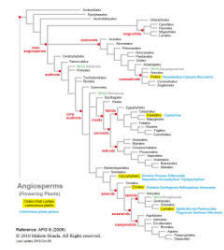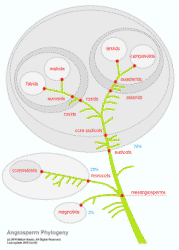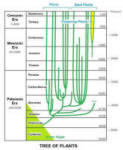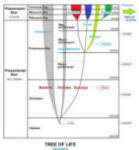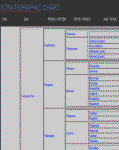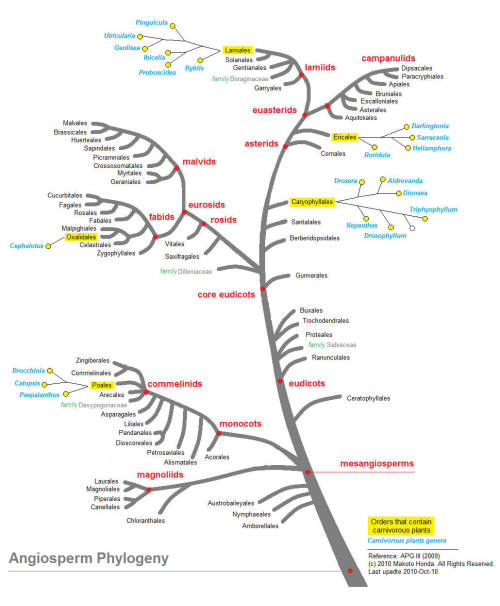Carnivorous Plants:
|
Classification
Phylogeny World Map Illustrations Glossary References |
|
CP
at a Glance CP Book Library CP Stamps CP Bibliography |
|
CP
Articles My CP Trip Summary |
|
More CP Photos B&W Photo Gallery Seed Photo Library Germination Photos |
|
IPS
CP Web Links |
|
Notes on
Photography My Photo Equipment |
HOME
|
||||||
| 2012-09-10 Flowering Plants Family Tree - APG III (2009) |
APG III - LIST APG III - TREE SUMMARY APG III - REAL TREE TREE OF PLANTS TREE OF LIFE STRATIGRAPHIC CHART
I
created a list of all flowering plants "orders" based on APG III (2009)
- Angiosperm Phylogeny Group. The APG is an international group of
systematists trying to establish a consensus on flowering plants
classification - a collaborative effort to construct a family tree of
plants utilizing molecular systematics. My main objective here is to put
the names of all taxonomic orders on one sheet of paper (8.5 x 11), so
that I can hold it in my hand. This is all the orders of green,
flowering plants on Earth today! Of course, I did not forget to identify
where our carnivorous plants occur. It took me one whole day to
put this list together. (Yep, I did not have anything better to do on
that day.) The only software I used for this is Microsoft Paint program.
Being a visually oriented human being, I wanted to see this phylogeny in
a pictorial form as well. So, first, I made a summary of the tree of
flowering plants: Major groupings are clearly shown in this simple tree,
such as "monocots" and "eudicots". Note that we do not have "dicots"
(having twin cotyledons) anymore because the dicots do not form a
"monophyletic" group (consisting of a node and all of its descentents).
Therefore the term dicots (dicotyledons) is now deprecated in taxonomic
classification.
Now a real tree. Oh boy, this took me two days to construct. I
think I did a pretty good job considering the only software I used is MS
Paint. Since a tree usually grows upwards, in defiance of Newton's gravity, I
started out by flipping (vertically) the first list I created, and
then manually added all branches, making sure the logical connections of
the original graph are not altered. Initially I wanted to "circle" all
major groupings as in the summary tree, but later decided against it to
avoid clutter due to unwanted overlaps of circles.
Human minds have a very strong cognitive power to interpret patterns (a
picture's worth a thousand words). That's why visual presentation is so
important and useful over textual information. Looking at the tree I
constructed, my brain can more easily recognize patterns and
relationships that are less obvious in the list presentation.
Carnivorous plants in the order Poales are rather isolated from the
rest, but it is somewhat expected considering they are all very
primitive, para-carnivorous plants.
It is readily observed that, within "core eudicots", carnivorous plants
are more numerous in the right major branch (leading to "asterids") than
the left major branch (leading to "rosids"). In fact, within rosids,
Cephalotus (Western Australian pitcher plant) is the only - and lonely -
carnivorous plant. The Cephalotus pitcher very much resembles that of
some tropical pitcher plants (Nepenthes), but the similarity is purely
the result of convergent evolution - acquisition of characters
resembling each other in function due to similar environmental
conditions, not due to common ancestry.
The branch leading to asterids is teemed with carnivores, starting with
the order Caryophylales, and then Ericales, and Lamiales. It appears
that it took nature (or the creator) a long time to come up with the
idea of bladderwort (and corkscrew) traps - and make them work
remarkably the way they do - because it is positioned at
the end of the long road. But then, I may be unduly influenced by a
particular way the tree graph is visually presented here.
When you are looking at any visualization, you always must be cognizant
of the level (or amount) of information present. In the case of this
phylogenetic tree I constructed, the length of each branch, for
instance, does not have any meaning. Whether a branch comes out on the
left or right of the tree is also arbitrary - a mere cosmetic decision.
__________________
If you are interested in printing these list/trees, click the above to
enlarge. And then, the best way to make a good hardcopy is to copy the
large image
and paste it onto your Word document, adjust the picture size, and then
print the document.
(If you notice a typo or any mistake in these list/chart,
please let me know.)
